|
|
Festival «Tibet-2004»
From October 14 th to 31 st, 2004, as the sign of growing interest of Russian auditorium to the culture of ancient Tibet, based on the principles of love and compassion, the first international festival “TIBET: traditions, art, philosophy” took place. The idea of this festival was blessed by the Noble Prize of Peace laureate His Holiness the Dalai Lama XIV. The festival is aimed to give the exhaustive presentation of cultural and philosophical inheritance of Himalayan region and also to trace the historical bonds, which existed between Russia and Tibet since many centuries.
About festival in details
Video
Exhibitions of festival «Tibet-2004»
 |
Most of the festival programs were presented in Russia for the first time. Among them is the personal photo exhibition of Richard Gere, who visited Moscow especially to take part in the festival. Gere considers His Holiness The Dalai-lama his teacher and friend, who graciously wrote the foreword to Gere’s book of photographs, which is aptly titled ‘Pilgrim’. The black and white pictures capture the tragedy, resilience, philosophy, character and spirit of Tibetans. |
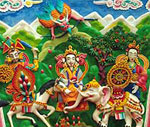 |
For the first time outside the Tibetan community, the masters from Gyudmed monastery were specially invited to create two-meters-high sculptures from butter depicting Buddhist saints and deities, like those that their monastery always raised in Lhasa, the capital of Tibet. Delicately made butter sculptures were made during the whole month by ten masters from Gyudmed. After that they were presented at the festival “TIBET” and consecrated during big colorful ceremony. |
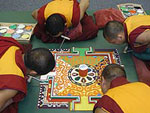 |
Guhyasamadji Sand mandala, the king of tantra – an exquisite palace from the grind marble of different colors was one of the main events of the festival. It happened for the first time in Russia. Such kind of mandala is done each year in Tibetan tantric monastery Gyudmed and is accompanied with the difficult rituals of many days. For many centuries already such palaces are raised to cultivate in people’s souls compassion to all sentient beings, to purify the surroundings and establish the harmony in the relations between people and all beings on the planet… On the opening day the monks carried out a beautiful ceremony of purifying the space, marked on the contours of mandala, and then, day by day, grain by grain, thoroughly created a handmade fragile miracle, astonishing us with beauty and perfection of forms. |
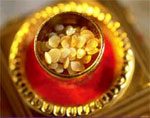 |
In 2001, Buddhist master, Lama Zopa Rinpoche, released this rare and precious collection of Buddhist relics for worldwide exhibition. In his collection there are real treasures not only connected with Buddhas (Kashyapa and Shakyamuni), but also with the legendary disciples of Buddha Shakyamuni - Maudgalyayana, Ananda and Sariputra. These relics have traveled around the world. Their amazing tour will go on till 2008 until the relics, that blessed the world, are placed in the completed 152meters high Maitreya Buddha statue. |
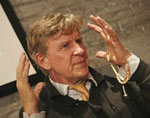 |
The collection, which for present moment is valued at more than million dollars, has about 150 unique examples of Tibetan art, created few hundred years ago. If the conflict situation in Tibet is solved at last, these masterpieces will return to their homeland. The aim of the international organization “Tibet House New York”, founded in 1987 by two American celebrities, professor Robert Thurman and actor Richard Gere under the patronage of His Holiness Dalai Lama – is studying and preserving of traditions and inheritance of the unique Tibetan culture… |
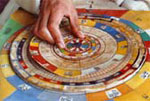 |
“Men-tsi-khang” was founded in the beginning of 1961 on the initiative of His Holiness Dalai Lama XIV in Dharmsala – the town on the north of India, where the spiritual and political centre of Tibetan people in exile is situated. Today “Men-tsi-khang” is a big medico-pharmaceutical and scientific-research centre, supplying more than 40 clinics in India and Nepal; from this place Tibetan doctors go around the world to give medical and what is more important spiritual care to people, without depending on their social status, race or religion. |
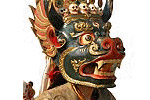 |
Impressive Cham masks are made in Kopan monastery (Kathmandu, Nepal) and by Sergei Pancheshny (Ìurmansk, Russia). A great place in the tradition of Tibetan Buddhism takes ancient mystery Cham. Speaking on the language of dance it tells us about Buddhist deities and masters. Dancer’s masks and costumes represent the same deities as depicted on the Buddhist icons, thangkas, that’s why one can say, that Cham is the “revived icon”. |
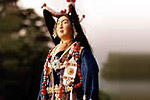 |
First time in Russia!
Collection of Tibetan hand-made dolls featuring Tibetan monks and lamas, Cham ritual dancers, Lhamo opera singers, Tibetan nomads. One can’t name the doll making a traditional Tibetan art, but nowadays, when the majority of Tibetans have to live in exile, this craft helps to preserve a rich culture of Tibetan national costume. Sometimes special expeditions are sent to ask the old men, find old drawings and photographs to be able to make a doll afterwards…
|
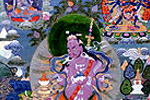 |
The partner of the festival “TIBET” – State Museum of Oriental Arts presented the best examples of Tibetan spiritual art from its extensive collections.
Tibetan artists, strictly following the canon, for centuries preserved the best achievements of Indian and Central Asian arts. Their creations possess serene simplicity and naive grace which are so typical for the pieces of art of the Ancient Russia icon painters and the artists of Early Renaissance… |
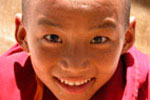 |
Rare pictures taken in Gyudmed Monastic University (Karnataka, India) by Igor Yanchoglov. |
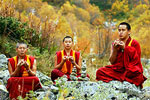 |
Amazing photographs made by Alexei Zamorkin, captured Gyudmed monks during their tours in Russia. |
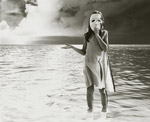 |
Photo series of Alyona Tel’puhovskaya is the view of a modern European person on the spiritual practices. Traveling to a geographical Tibet the author makes a long journey for the sake of finding herself. |
Lections and presentations of festival «TIBET»
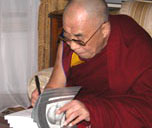 |
Unique video course of lections of His Holiness Dalai-lama XIV.
The basic principles of Buddha teachings told by the spiritual leader of Tibetan people. On July 1996 His Holiness Dalai-lama XIV for two days was giving lectures on Four Noble Truths in London. It was a really historical event! For the first time he gave these teachings on the West, for the first time His Holiness was invited by the representatives of all Buddhist traditions to give the explanations on these principal truths.
|
 |
Lections of professor of Columbia University and the president of “Tibet House New York” Robert F. Thurman (New York, USA) about Tibet, Buddhism and the psychology of Tibetan Buddhism. Robert A. F. Thurman is one of the most famous tibetologists of our time, the head of the department in a Columbia University, and the first American to become a Tibetan Buddhist monk. “The Times” named him as one of 25 Most Influential People of America. |
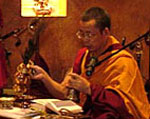 |
Lecture course of Tsering Dhondup, culture and religion consultant of Tibet center of Culture and Information in Moscow, on the basic text of Mahayana Buddhism “Bodhicharya-avatara”. Text is composed by the greatest Buddhist master and scholar of Nalanda university Shantideva in the 8th century. Tsering Dhondup was born in 1954 in the village of Tzona-Dzong on the south of Tibet. When he was five he left Tibet together with his parents, as well as more than hundred thousands of Tibetans, that became refugees in 1959 and the beginning of sixties. He grew up in India, became a Buddhist monk, and at the age of 25 took a full monastic empowerment from His Holiness Dalai-lama. |
 |
Lections of ngagrampa (doctor of Tantra) Lobsang Tsering
(tantric Gyudmed monastery, Karnataka, India).
Lobsang Tesing was born in 1967 in India, in the family of Tibetan refugees, who left Tibet in 1959. At the age of twelve he became a monk in one of the most honorable monasteries of Tibet – tantric monastic university of Gyudmed. In 1996 he completed many years of studies of tantric philosophy, rituals and arts, having got the degree of ngagrampa (doctor of Tantra).
|
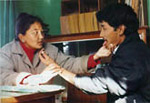 |
Lection of the doctor Tenzin Deche Kartsang
(“Men-tsi-khang” Tibetan institute of medicine and astrology. Dharmsala, India). Doctor Tenzin Deche Kartsang was born in 1962. Since 1999 he is a practicing doctor in the “Men-tsi-khang” branch-office in New Delhi. He also makes the researches in the field of the effective influence of Tibetan medicine on the cancer patients. |
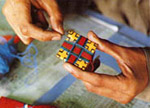 |
Lection of Phurbu Tsering (“Men-tsi-khang” Tibetan institute of medicine and astrology. Dharmsala, India). Phurbu Tsering was born on the north of India in 1972. In 1992 he started the astrology course in Men-tsi-khang and in 1997 graduated it with honors. Then he had a probation period on the faculty of astrology under the guidance of the senior astrologists. In 1999 he gave the Tibetan astrology course to the students from western countries. In 2000 he participated in the Folklore Tibetan Culture Festival in the Smithson Museum in Washington. |
Concerts and Buddhist ceremonies of festival «TIBET»
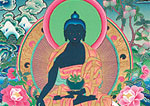 |
Buddha Medicine is responsible for healing powers of space. He is the reason for appearing of “Four medical tantras”, which are the basic of world known Tibetan medicine, that removes not the symptoms, but the roots of the disease. During two hours ritual the monks offer the sounds of dulcimers, bells and long trumpets to Buddha Medicine and ask him to save from sufferings, connected with different kinds of illnesses.
This ritual, based on sacred texts and mantras, is supposed to eliminate all the obstacles, arising on the way to recovery.
|
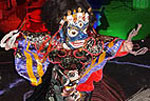 |
The basis of the theatre’s musical mysteries is ancient Tibetan tantric rituals, Tibetan folklore and deities’ dances of the Cham mystery.
Musicians of the theatre skillfully perform the chanting styles of Tibetan monks “gyuke” and “dzoke”, play traditional temple Tibetan instruments, they also use various ethnic musical instruments, pictures from their expeditions and theatrical methods of the European stage in their performances.
Detailed information about the theater
- www.lungta.ru |
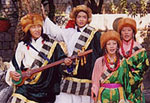 |
Ancient chants of Tibetan nomads by Jamyang and Yangchen (Dharamsala, India).
Jamyang and Yangchen were born in a boundless Tibetan province Amdo, where His Holiness Dalai-lama got his fourteenth incarnation. They have been singing since early childhood, and inherited their singing talent from their parents. Their fortune is much similar to that of the thousands of other Tibetan refugees, who fled to India crossing the Himalayan ridge to be closer to Dalai-lama….
|
 |
Without any exaggeration one can call the overtone chanting of Tibetan monks the visiting card of Tibet. In any film, in any musical composition about the Legendary Roof of the World, one can hear their low voices of a startling depth and power, bringing with them the energy of utterly other, unknown, but magnetic world. Not many people know though that among thousands of monasteries in Tibet only two sing in this style. One of them is Gyudmed, the monastery with the five hundred year tradition, which appeared soon after its founder, Tibetan lama Sherab Senge heard an amazing voice in a prophetical dream. |
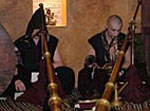 |
Legendary project of Aleksei Tegin “Phurpa” appeared in Moscow at the beginning of the nineties. During the years of its existence many things changed – the musician team and the music itself, but its inner content remained permanent – to follow the Bon path, the ancient pre-buddhist tradition of Tibet. At a present moment “Phurpa” reconstruct archaic overtone chanting of bonpo priests, which is characteristic of the infratonal saturation together with the lower register if to compare with the Buddhist liturgies. |
 |
“Gangjong Doeghar” is a gorgeous company of Tibetan songs and dances performers. It was founded in Kalimpong, the northern settlements of Tibetan refugees in India. In “Gangjong Doeghar’s” repertoire is almost the whole range of spiritual and secular music of Tibet, here are the sacral dances of deities-animals, and ritual dances of the hunters; melodious and long folk songs, and opera “Lhamo”… Despite the young age, the musicians and dancers of “Gangjong Doeghar” already traveled all over the world, they gave concerts in Great Britain and Ireland, Holland and France. And everywhere the spectators admire the beautiful songs and mysterious melodies of the Snow Country. |
 |
Special guest of the gala-concert is Loten, meaning in Tibetan “The White Crane” –this is the artist’s stage name. His real name is Namling Lobsang Tenzin. The son of Tibetan refugees, he was born in Dharamsala in 1963. At the age of fifteen his parents gave him danien, six-string Tibetan lute as a present. That defined his further fortune… His interest to the modern western music impelled him creating the project “Tibet-blues“, on which Loten is working now. |
|
|
![]()
![]()
![]()
![]()